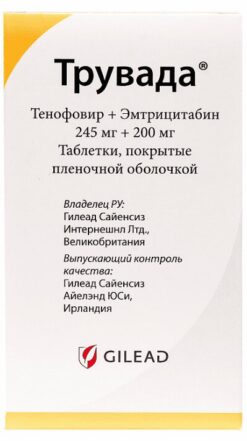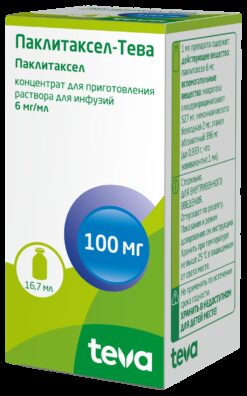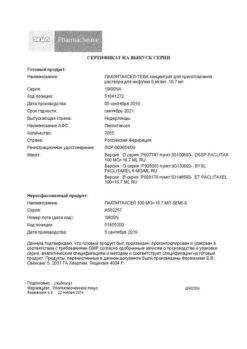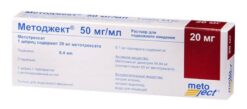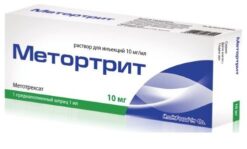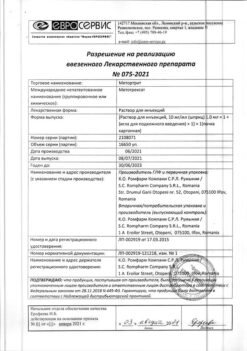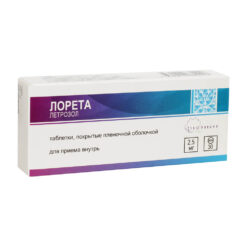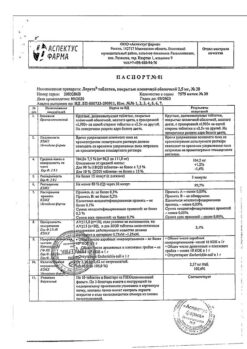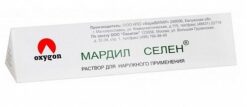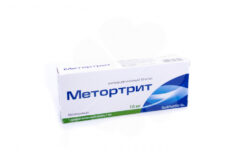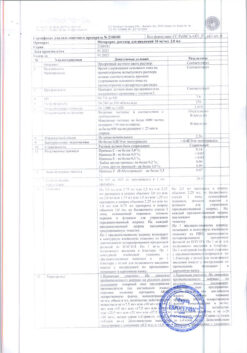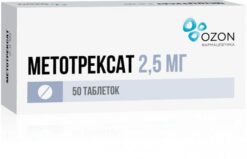No products in the cart.
Description
Pharmacotherapeutic group: antitumor drug, alkylating compound
ATC code: L01XA02
Pharmacodynamics:
Carboplatin is a complex compound containing the heavy metal platinum. The main mechanism of action of this drug is due to the formation of cross-links between neighboring pairs of guanine bases in DNA that leads to suppression of nucleic acid synthesis and cell death. Hydration of carboplatin resulting in the formation of the active form(s) of the drug is slower than hydration of cisplatin. Unlike cisplatin it is less nephrotoxic and ototoxic and more strongly suppresses hematopoiesis. Causes growth arrest and reverse development of many types of tumors. In experimental studies in vivo and in vitro it shows mutagenic embryotoxic and teratogenic properties.
Pharmacokinetics:
Weakly bound to blood proteins. T1/2 in the initial phase – 11-2 h in the final phase – 26-59 h; volume of distribution – 16 l. It is excreted by kidneys (at a KPI of 60 ml/min or more during 12 hours, 65% of the dose is excreted during 24 hours – 71%). Metabolized by hydrolysis to form active compounds that interact with DNA. Binding to plasma proteins is very low. Platinum released from carboplatin irreversibly binds to plasma proteins and is slowly excreted with a minimum T1/2 – 5 days.
Indications
Indications
– Ovarian cancer (primary treatment as part of combination chemotherapy and secondary – palliative treatment in later stages);
– germ cell tumors of men and women;
– tumors of the head and neck;
– lung cancer;
– cervical cancer;
– transitional cell carcinoma of the bladder.
Pharmacological effect
Pharmacological effect
Pharmacotherapeutic group: antitumor agent, alkylating compound
ATX code: L01XA02
Pharmacodynamics:
Carboplatin is a complex compound containing the heavy metal platinum. The main mechanism of action of this drug is due to the formation of cross-links between adjacent guanine base pairs in DNA, which leads to suppression of nucleic acid synthesis and cell death. The hydration of carboplatin, resulting in the formation of the active form(s) of the drug, occurs more slowly than the hydration of cisplatin. Unlike cisplatin, it has less nephrotoxicity and ototoxicity and inhibits hematopoiesis more strongly. Causes growth arrest and reverse development of many types of tumors. In experimental studies in vivo and in vitro, it exhibits mutagenic embryotoxic and teratogenic properties.
Pharmacokinetics:
Weakly binds to blood proteins. T1/2 in the initial phase – 11-2 hours in the final phase – 26-59 hours; distribution volume – 16 l. Excreted by the kidneys (with CC 60 ml/min or more within 12 hours, 65% of the dose is excreted in 24 hours – 71%). Metabolized by hydrolysis to form active compounds that interact with DNA. Plasma protein binding is very low. Platinum released from carboplatin irreversibly binds to plasma proteins and is slowly eliminated with a minimum T1/2 of 5 days.
Special instructions
Special instructions
The administration of Carboplatin-RONC® should be carried out under the supervision of a physician experienced in the use of cytotoxic drugs. Constant monitoring of possible toxic effects during treatment with carboplatin is mandatory, especially when using high doses of the drug.
Do not use needles, syringes, catheters and infusion systems containing aluminum for the preparation and administration of the drug, which can react with carboplatin leading to the formation of sediment or loss of activity of the drug.
Regularly (once a week) monitoring of peripheral blood cells and indicators of renal function (the most sensitive indicator is creatinine clearance) and liver function should be carried out.
Periodic neurological examinations are recommended, especially in patients previously treated with cisplatin and in patients over 65 years of age.
Since Carboplatin-RONC® may cause cumulative ototoxic effects, patients are recommended to undergo audiographic studies before and during treatment. In case of clinically significant impairment of hearing function, an appropriate change in the dose of the drug or discontinuation of treatment may be required.
Women and men should use reliable methods of contraception during treatment with carboplatin.
When using Carboplatin-RONC®, all usual instructions for the use of cytotoxic drugs must be followed.
In the presence of concomitant ascites or exudative pleurisy, the toxicity of carboplatin increases.
Subsequent doses of Carboplatin-RONC® are not recommended until the platelet count reaches 100 thousand/μl and neutrophils – 2 thousand/μl.
In patients who develop thrombocytopenia while taking carboplatin, special precautions must be taken to prevent bleeding and hemorrhage: caution when performing invasive procedures; regular inspection of intravenous injection sites of the skin and mucous membranes for bleeding and hemorrhage; limiting the frequency of venipuncture and refusing IM injections; analysis of urine, vomit, feces and secretions for occult blood; caution when using toothbrushes and floss, toothpicks, safety razors and scissors; prevention of constipation; preventing falls or other injuries; Avoid ethanol and ASA.
It is necessary to avoid contact with patients with bacterial infections, especially against the background of developed leukopenia.
If your body temperature rises or chills appear, cough or hoarseness, pain in the lower back or side, painful or difficult urination, you should consult a doctor immediately.
During treatment, it is not recommended to vaccinate patients or their family members and it is also necessary to avoid contact with people who have received the polio vaccine or wear a protective mask.
Impact on the ability to drive vehicles. Wed and fur.:
Considering that when using Carboplatin-RONC®, patients may experience peripheral neuropathy, visual impairment and color vision impairment, during the administration of the drug, one should refrain from driving vehicles and machinery and performing other work that requires concentration and speed of psychomotor reactions.
Active ingredient
Active ingredient
Carboplatin
Composition
Composition
1 ml of concentrate contains:
active substance: carboplatin 10 mg;
excipients: water for injection – up to the required volume.
Contraindications
Contraindications
– Hypersensitivity to carboplatin and other platinum-containing compounds;
– severe renal dysfunction (creatinine clearance equal to or below 15 ml/min);
– heavy bleeding;
– severe myelosuppression;
– pregnancy and lactation period;
– children’s age (safety and effectiveness have not been studied enough).
With caution:
Carboplatin should be used with caution when:
– acute infectious diseases of a viral fungal or bacterial nature (including chickenpox and herpes zoster);
– hearing impairment;
– inhibition of bone marrow hematopoiesis (including against the background of concomitant radiation or chemotherapy);
– previous therapy with nephrotoxic drugs such as cisplatin;
– post-vaccination period.
Side Effects
Side Effects
From the hematopoietic organs: the main toxic factor limiting the dose of carboplatin is the suppression of the function of bone marrow hematopoiesis. Myelosuppression is dose dependent. The lowest level of platelets and leukocytes/granulocytes is usually achieved 2-3 weeks after starting the drug, and thrombocytopenia is more common. Adequate recovery to levels allowing the next dose of carboplatin usually takes at least 4 weeks. A fairly large number of patients may also exhibit symptoms of anemia (hemoglobin value less than 11 g/dl), the intensity of which depends on the total dose of the drug. There may be a need for transfusion therapy, especially in patients undergoing long-term treatment (for example, more than 6 cycles of the drug). There is also the possibility of clinical complications such as fever, infectious diseases, sepsis/septic shock and carboplatin (reduced clearance, bleeding.
From the gastrointestinal tract: in the first 6-12 hours after taking the drug, there is a possibility of nausea and/or vomiting lasting up to 24 hours or longer. The risk of emetic effects may be reduced by prophylactic therapy with antiemetics. In some cases, other types of undesirable effects on the gastrointestinal tract may be observed, such as inflammation of the oral mucosa, diarrhea, constipation and abdominal pain.
From the central nervous system and peripheral nervous system: there is a possibility of peripheral neuropathies, mainly in the form of paresthesia and decreased deep tendon reflexes, which is more likely in patients over 65 years of age with long-term or previous treatment with cisplatin. Symptoms of central nervous system dysfunction may also appear. Long-term drug therapy may lead to cumulative neurotoxicity.
From the kidneys: a temporary increase in the concentrations of creatinine and urea in the blood serum may be observed. Acute kidney damage may occur. The risk of nephrotoxicity during administration may be a slight and usually temporary increase in AST creatinine concentrations) increases with increasing doses of carboplatin and also in patients who have previously been treated with cisplatin.
From the electrolyte balance: hypokalemia, hypocalcemia, hyponatremia and/or hypomagnesemia are possible.
Allergic reactions: erythematous rash, fever, itching, urticaria, bronchospasm, arterial hypotension and anaphylactic reactions. These reactions may occur within minutes of carboplatin administration. Exfoliative dermatitis may occur.
On the part of the hearing organ: ototoxicity manifests itself in the form of tinnitus and hearing impairment.
From the visual system: there is a possibility of temporary deterioration or complete loss of vision (possible loss of the ability to distinguish colors and see light) as well as other disturbances in visual function. Improvement and/or complete restoration of vision usually occurs within a few weeks after stopping the drug. Cortical blindness has been observed in patients with impaired renal function treated with high doses of carboplatin.
From the hepatobiliary system: a temporary increase in alkaline phosphatase bilirubin concentration in the blood serum may be observed. Significant liver dysfunction was observed in patients receiving high doses of carboplatin with autologous bone marrow transplantation.
Local reactions: pain at the injection site, allergic reactions.
Other side effects: changes in taste alopecia asthenia flu-like symptoms (increased body temperature fever) hemolytic uremic syndrome myalgia/arthralgia heart failure cerebrovascular disorders.
Interaction
Interaction
It is not recommended to prescribe simultaneously with other drugs that have myelosuppressive nephrotoxic or neurotoxic effects.
Strengthens (mutually) the nephrotoxicity of aminoglycosides and other nephrotoxic drugs.
Reduces the production of antibodies to the introduction of an inactivated viral vaccine and a live viral vaccine (in addition, it is possible to intensify the process of replication of the vaccine virus and increase its side effects). The interval between discontinuation of carboplatin treatment and vaccination should be 3 to 12 months. (depends on the dose and type of drug for the underlying disease and other factors).
Overdose
Overdose
Specific antidotes for carboplatin overdose are not known. In case of overdose, dose-dependent adverse reactions may increase. Treatment is symptomatic.
Storage conditions
Storage conditions
At a temperature of 15 to 25 ° C in a place protected from light.
Keep out of the reach of children.
Do not freeze.
Shelf life
Shelf life
2 years.
Do not use the drug after the expiration date indicated on the package.
Manufacturer
Manufacturer
Federal State Budgetary Institution National Medical Research Center of Oncology named after. N.N. Blokhina, Russia
Additional information
| Shelf life | 2 years. Do not use after the expiration date printed on the package. |
|---|---|
| Conditions of storage | With temperature from 15 to 25 ° C in a light-protected place. Store out of reach of children. Do not freeze. |
| Manufacturer | N.N. Blokhin Scientific Research Center for Oncology, Russia. N.N. Blokhin Cancer Research Center, Russia |
| Medication form | concentrate for preparation of infusion solution |
| Brand | N.N. Blokhin Scientific Research Center for Oncology, Russia. N.N. Blokhin Cancer Research Center |
Related products
Buy Carboplatin-RONC, 10 mg/ml 15 ml with delivery to USA, UK, Europe and over 120 other countries.


